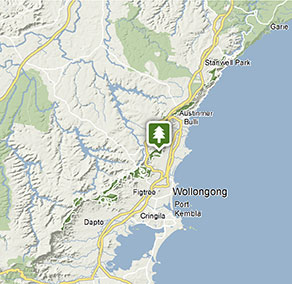Illawarra Escarpment State Conservation Area
Visitor info
All the practical information you need to know about Illawarra Escarpment State Conservation Area.
Getting there and parking
Get driving directions
From Sydney:
- Drive south along the Princes Highway. Exit at Helensburgh for Stanwell Park, Sublime Point for the Sublime Point Track, or at Figtree for Mount Keira.
From Stanwell Park:
- Drive south (1km) along Lawrence Hargrave Drive to the start of the Forest Walk
From Wollongong:
- Drive west along Mount Keira Road to Byarong Park at Mount Keira, or via Cordeaux Road to Mount Kembla.
Please note: There is no access to Illawarra Escarpment State Conservation Area from Brokers Nose and Brokers Point via Hawthorn Street, as this is private property.
Park entry points
- Mount Kembla access See on map
- Mount Kiera North access See on map
Parking
- Byarong Park picnic area See on map
- Robertson lookout See on map
By bike
Check out the Bicycle information for NSW website for more information.
By public transport
Illawarra Escarpment State Conservation Area is accessible by train from Sydney via the Cityrail South Coast Line to Stanwell Park, Coalcliff, Austinmer or Wollongong.
For information about public transport options, visit the NSW transport info website.
Best times to visit
There are lots of great things waiting for you in Illawarra Escarpment State Conservation Area. Here are some of the highlights.
Spring
Enjoy a native wildflower display on the Forest walk.
Summer
Cool your heels on the Mount Keira ring track, which threads through refreshing rainforest.
Winter
Take advantage of the escarpment elevation for a spot of whale watching north of Mount Keira, or from one of the several lookouts.
Weather, temperature and rainfall
Summer temperature
Average
16.5°C and 25.6°C
Highest recorded
42.3°C
Winter temperature
Average
8.3°C and 18.3°C
Lowest recorded
-0.5°C
Rainfall
Wettest month
April
Driest month
August
The area’s highest recorded rainfall in one day
316mm
Facilities
Toilets
Picnic tables
Barbecue facilities
Drinking water
Maps and downloads
Prohibited
Pets
Pets and domestic animals (other than certified assistance animals) are not permitted. Find out which regional parks allow dog walking and see the pets in parks policy for more information.
Smoking
NSW national parks are no smoking areas.

Contact
- in the South Coast region
Illawarra Escarpment State Conservation Area is always open but may have to close at times due to poor weather or fire danger. However, it is recommended that bushwalking only be undertaken during daylight hours because of the presence of cliff edges and other hazards.
-
-
Wollongong office
02 4224 4188
Contact hours: Monday to Friday, 8.30am to 4.30pm. - Unit G Ground Floor, 84 Crown Street, Wollongong NSW 2500
-
Email: npws.illawarrahighlands@environment.nsw.gov.au
-
Wollongong office
Nearby towns
Wollongong (9 km)
There are plenty of opportunities for adventure activities in and around Wollongong ranging from surfing and swimming to sailing, hang gliding, paragliding, cycling and abseiling. Wollongong is the only place in NSW where you can skydive onto the beach.
Stanwell Park (32 km)
Stanwell Park is a small coastal town with a glorious surf beach. It's set dramatically against the steep, forested escarpment cliffs.
Sydney City Centre (107 km)
No trip to Sydney is complete without spending some time in the city’s beautiful parks. Whether it’s in central areas like Hyde Park or the Royal Botanic Gardens or further out in Centennial Parklands, there’s plenty of green space to go out and enjoy.